September 13, 2011
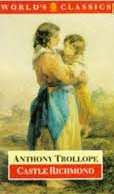 Before you even accuse me of repetitiveness, I already know that I just did a Cocktail Talk post containing an Anthony Trollope quote (the one from The Three Clerks below). Or just a few weeks ago. But, but, but I also just read a different Trollope book, Castle Richmond, and it also had a few worthy quotes, one of which is below. See, I’ve run into a little Trollope luck lately, finding a few of the less-easy-to-find books, and so have been reading my Trollope-loving-heart out. Usually when browsing a bookstore, you’re only going to find a book from the Chronicles of Barsetshire (probably Barchester Towers or The Warden) and maybe something from the Palliser novels (usually, for reasons unknown to me, The Eustace Diamonds, which pales in my mind to Phineas Finn). The lesser known Trollope numbers? Not so much. Which is why, since I recently did find a few of these, A: I’m pretty excited, B: I’ve been reading so much Trollope, and C: why you, lucky people, get another quote about booze and boozing from a Trollope book. This may be, by the way, the finest whiskey punch quote ever. Castle Richmond itself is a darn fine read, an Irish tale which takes place during the potato famine with Trollope’s usual keen observing of politics, both personal and public. And with whiskey punch:
Before you even accuse me of repetitiveness, I already know that I just did a Cocktail Talk post containing an Anthony Trollope quote (the one from The Three Clerks below). Or just a few weeks ago. But, but, but I also just read a different Trollope book, Castle Richmond, and it also had a few worthy quotes, one of which is below. See, I’ve run into a little Trollope luck lately, finding a few of the less-easy-to-find books, and so have been reading my Trollope-loving-heart out. Usually when browsing a bookstore, you’re only going to find a book from the Chronicles of Barsetshire (probably Barchester Towers or The Warden) and maybe something from the Palliser novels (usually, for reasons unknown to me, The Eustace Diamonds, which pales in my mind to Phineas Finn). The lesser known Trollope numbers? Not so much. Which is why, since I recently did find a few of these, A: I’m pretty excited, B: I’ve been reading so much Trollope, and C: why you, lucky people, get another quote about booze and boozing from a Trollope book. This may be, by the way, the finest whiskey punch quote ever. Castle Richmond itself is a darn fine read, an Irish tale which takes place during the potato famine with Trollope’s usual keen observing of politics, both personal and public. And with whiskey punch:
But the parlor was warm enough; warm and cosy, though perhaps at times a little close; and of evenings there would pervade it a smell of whisky punch, not altogether acceptable to unaccustomed nostrils. Not that the rector of Drumbarrow was by any means an intemperate man. His single tumbler of whisky toddy, repeated only on Sundays and some rare other occasions, would by no means equal, in point of drinking, the ordinary port of an ordinary English clergyman. But whisky punch does leave behind a savour of its intrinsic virtues, delightful no doubt to those who have imbibed its grosser elements, but not equally acceptable to others who may have been less fortunate.
—Castle Richmond, Anthony Trollope
July 14, 2011
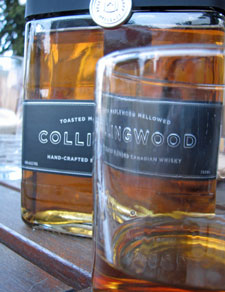 Before diving into Part 2 of my interview with Master Distiller Chris Morris, who is the creative force behind the new Collingwood Canadian whisky, I suggest if you haven’t that you take a gander at Collingwood Interview Part 1, below. For one, you can learn more about Canadian whisky (if you need to), learn about the process behind Collingwood, see the word “saccharified” used in a sentence, and more.
Before diving into Part 2 of my interview with Master Distiller Chris Morris, who is the creative force behind the new Collingwood Canadian whisky, I suggest if you haven’t that you take a gander at Collingwood Interview Part 1, below. For one, you can learn more about Canadian whisky (if you need to), learn about the process behind Collingwood, see the word “saccharified” used in a sentence, and more.
I’d also suggest pouring yourself (if possible) a nice dollop of Collingwood before reading the rest of the interview. I, myself, am having a glass as I type (I certainly wouldn’t want you doing anything I wouldn’t do), and enjoying it lots*. As mentioned in Part 1, I like Canadian whisky, as it tends to be smooth and very sip-able. Collingwood is, I think, a step above most, adding more spice notes without sacrificing smoothness and bringing a delightful sweet end note at the very last moment. But really, Chris is going to describe it in much greater detail below, so start reading.
A.J.: If you had to describe Collingwood’s taste to the home drinker, how would you describe it?
Chris: Collingwood’s unique finishing practice, the post blending maple mellowing process, creates a whiskey that is rich in sweet and spicy notes and is smooth on the palate. Aroma–graham cracker sweetness with delicate notes of vanilla, caramel and butterscotch underpinned by a rich floral (rose petal) and fruit character. Taste–creamy with a prickly vibrancy that fades into a delicate marzipan-dusted grain note. Faint hints of maple syrup drift about. Nice complexity. Finish–warm, sweet and long with a lingering floral and light malt whisky character.
A.J.: To step back to Canadian whisky in general, it seems (to me) that at one time there were more cocktails that called for Canadian whisky specifically, and then a little lull (outside of basic highball type drinks). Do you think there’s a resurgence happening in Canadian whisky cocktails? And if so, why?
Chris: The Canadian whisky category hasn’t yet benefited from the current cocktail craze to the degree that Kentucky Bourbon and Rye whiskies have due to the fact that, in general, it is composed of light and gentle tasting brands. These are easily dominated by mixers such as bitters and sweet vermouth. Complex and more favorable brands like Collingwood will help change that perception.
A.J.: Following the previous question up, are there certain known cocktails that you think would benefit from Collingwood being subbed in? How would a Collingwood Manhattan be, for example?
Chris: Collingwood would be a good addition to an Old Fashioned cocktail. The fruit selection for muddling would need to be adapted to complement its floral/fruit character.
A.J.: When someone tastes Collingwood for the first time, would you suggest they try it straight, with ice, with water, or in a cocktail? And how do you normally drink it?
Chris: I think the best way to introduce Collingwood to the palate is neat. That will emphasize its smooth character while at the same time deliver its rich flavor and vibrant spice notes. I drink Collingwood just that way–straight up.
A.J.: The Collingwood bottle is very unique and intriguing–how did the design come about? And do you feel it reflects the whisky’s personality?
Chris: The Collingwood bottle design is intended to make the statement that this is not just any Canadian whisky–it is new, contemporary, and stands out from the crowd. It is a whiskey designed to refine the Canadian Whisky category and refine yourself at the same time. The bottle definitely does reflect the unique personality of the whiskey.
*Much like in Collingwood, Part 1, I’d like to admit that I received a bottle of said Canadian whisky to test as part of this interview. And test it I did, many glasses of testing. I suggest you do the same.
July 12, 2011
 Sometimes, being a person who writes about cocktails leads to some tasty situations (and I’m not just saying this to start jealous rages out there, just stating a fact. And hey, sometimes I write about them on this very blog, sharing the tastiness). One recent example sent my focus northwards, towards our friendly neighbor nation, Canada. See (to stop being mysterious) I recently received the news that Washington state was going to be one of the first states to get to try the new Collingwood Canadian whisky*.
Sometimes, being a person who writes about cocktails leads to some tasty situations (and I’m not just saying this to start jealous rages out there, just stating a fact. And hey, sometimes I write about them on this very blog, sharing the tastiness). One recent example sent my focus northwards, towards our friendly neighbor nation, Canada. See (to stop being mysterious) I recently received the news that Washington state was going to be one of the first states to get to try the new Collingwood Canadian whisky*.
I tend to like Canadian whiskies (really, I tend to like all the boozes, as you probably know), and think sometimes they don’t get a serious look in our modern cocktail-and-liquor culture. Which is a shame, but hopefully a shame that will be rectified as folks continue their liquor explorations and as new distillers put their stamp on the genre with whiskies like Collingwood. Distillers like (for example, and yes this rambling is going someplace) Brown-Foreman Master Distiller Chris Morris, who was responsible for Collingwood. And who (see how this all ties back into that tasty situations bit above) was kind enough to take some time to talk about Collingwood, Canadian whiskies, and the distillery process. Because I’m wordy, the interview went on a bit, so I’m breaking it into two sections. Part 1 starts below, and Part 2 will be on the blog in a few days.
Oh, one more thing: if you live in Washington (or in Florida, Kentucky, Louisiana, or Texas, which are the states Collingwood is currently available within–though by the time you read this, your state may have it, too), I strongly suggest you pick up a bottle of Collingwood before starting to read. Because you’ll surely want a glass for sipping by the time you finish reading.
A.J.: To get started, for those out there who may not know (even those who don’t want to admit it), could you give a quick primer on Canadian whisky? Is it just whisky made in Canada? What else defines it?
Chris: I think the Canadian whisky category is one of the least understood in the whiskey family. By definition, a Canadian whisky is a potable distillate, or a mixture of distillates obtained from a mash of cereal grain or grain products that have been saccharified (turned into sugar) by a diastase of malt or other enzymes. Spirit is created by fermentation with yeast or a mixture of yeast and other micro-organisms and then aged in wood for not less than three years. All of this activity must of course take place in Canada. Bottling of the product can take place outside of Canada as long as the product is not presented at less than 80 proof (40% abv). The final product presentation may contain caramel coloring and flavoring.
A.J.: And to follow that up, what sets the new Collingwood apart from other Canadian whiskies? And, from other whiskies in general?
Chris: Collingwood adds an extra dimension to the Canadian whisky production process with its introduction of the Toasted Maplewood Mellowing process. Other than Jack Daniel’s use of Hard Sugar Maple charcoal in its mellowing process and the Woodford Reserve Master Collection’s Maple Wood Finish product, no other whiskey uses Hard Sugar Maple wood in its production process.
A.J.: As you were constructing Collingwood, were there certain, let’s call them whisky personality traits that you were aiming for?
Chris: Our objective in crafting Collingwood was to create a new style of Canadian whisky that was more complex without adding lots of blenders, flavors, etc. We wanted a Canadian whisky that would rival the great Single Malts from Europe in style and complexity.
A.J.: As a Master Distiller, are there specific steps and paths you take when crafting a new whisky, or more experiments, or a bit of both?
Chris: A Master Distiller should draw upon their years of experience as a source for inspiration and innovative concepts. The resulting concepts must be validated through rigorous experimentation that sometimes takes years.
A.J.: Was there anything in the process of crafting Collingwood that surprised you?
Chris: Experience has taught us to expect the unexpected. That is where the “ah ha!” factor comes into play. Sometimes during experimentation a new course to follow or concept to pursue develops that is more interesting (tasty) than the original one. We thought that Collingwood would be sweeter rather than more spicy than it turned out. It was a great development.
Okay whisky-adoring kiddies, that’s the end of Part 1 of interview with Master Distiller Chris Miller. Be sure to come back in a few days for the rest of the interview, to learn more about the new Collingwood Canadian whisky (including tasting notes and Chris’ choice for a cocktail utilizing it) and to tempt your liquor-loving tastebuds.
*To be completely open and honest, I did receive a bottle of Collingwood in the mail. But I wouldn’t ever tell you I liked something I didn’t actually like, friend. And I liked the Collingwood lots.
May 16, 2011
 First, an apology for the lack of posting. Moving back to Seattle from the I-tal has been a process, and has left me with little umph for blogging. Or, after reading (re-reading really, as I’ve read it at least once, and probably twice, before) Graham Greene’s somewhat funny/somewhat serious Cuban spy-and-not novel Our Man in Havana, I’ve been too inclined to have a daiquiri at noon for blogging. I like that take on things much better, so let’s go with that excuse, and start a rumor of me being a two-daiquiris-at-noon fella. Heck, maybe I’ll even inspire you to start. If I don’t, hopefully this quote does (or starts you collecting miniature bottles of whiskies):
First, an apology for the lack of posting. Moving back to Seattle from the I-tal has been a process, and has left me with little umph for blogging. Or, after reading (re-reading really, as I’ve read it at least once, and probably twice, before) Graham Greene’s somewhat funny/somewhat serious Cuban spy-and-not novel Our Man in Havana, I’ve been too inclined to have a daiquiri at noon for blogging. I like that take on things much better, so let’s go with that excuse, and start a rumor of me being a two-daiquiris-at-noon fella. Heck, maybe I’ll even inspire you to start. If I don’t, hopefully this quote does (or starts you collecting miniature bottles of whiskies):
‘Eighteen different kinds of scotch,’ the stranger said, ‘including Black Label. And I haven’t counted the Bourbons. It’s a wonderful sight. Wonderful,’ he repeated, lowering his voice with respect. ‘Have you ever seen so many whiskies?’
‘As a matter of fact I have. I collect miniatures and I have ninety-nice at home.’
‘Interesting. And what’s your choice today? A dimpled Haig?’
‘Thanks, I’ve just ordered a daiquiri.’
‘Can’t take those things. They relax me.’
—Our Man in Havana, Graham Greene
May 5, 2011
Well, we’re back (from Italy, that is. If you didn’t know it, wife Nat and I and our two dogs have been enjoying our Italian pre-tirement for the last seven or so months. Interested? Read more about it). Re-entry into life into Seattle hasn’t been rough, but neither has it been a box of chocolates filled with booze. To ease the edges, and to help remind me of things from here I missed, when there, without forgetting what I loved there, I whipped up the following cocktail last night, and think I’ll be whipping up a few more over the next couple of days. See, bourbon is hard to track down in the I-tal, and so I wanted the drink to be serious on the bourbon side. But, I miss (already) having loads of Italian liqueurs in every café and bar, so I wanted hints of Italy surrounding the bourbon. Which led to the Welcome Back, Weary Traveler:
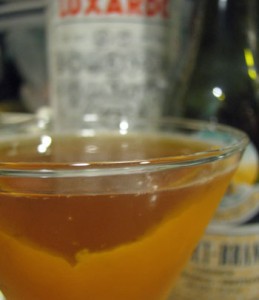
2-1/2 ounces bourbon (I used Blanton’s, but others may suffice)
1/2 ounce Luxardo Maraschino
1/4 ounce Fernet Branca
Orange twist, for garnish (I like’d a wider orange twist here)
1. Fill a cocktail shaker or mixing glass halfway full with cracked ie.
2. Add the bourbon, maraschino, and Fernet Branca. Stir well.
3. Strain into a cocktail glass or a stewardesses hat. Twist the twist and drink as happily as you can manage.
Tags: Blanton's, bourbon, cocktail recipe, Cocktail Recipes, Dark Spirits, drink recipes, Fernet Branca, Luxardo Maraschino, Recipes, What I'm Drinking, Whiskey
Posted in: Almost Drinkable Photo, Italy, Liqueurs, Recipes, What I'm Drinking, Whiskey
April 26, 2011
 The following two quotes, the last of those from the Raymond Chandler book Pearls Are A Nuisance, which I talk about more in Take 1, below Take 2, which is below this post right here and now. These quotes are from the final story in the collection, “The King in Yellow” and include one about drinking light and one about drinking heavier. Not a bad way to end up, though I think Mr. Chandler would be more happy with the latter, were he still around to drink with (sadly, not the case).
The following two quotes, the last of those from the Raymond Chandler book Pearls Are A Nuisance, which I talk about more in Take 1, below Take 2, which is below this post right here and now. These quotes are from the final story in the collection, “The King in Yellow” and include one about drinking light and one about drinking heavier. Not a bad way to end up, though I think Mr. Chandler would be more happy with the latter, were he still around to drink with (sadly, not the case).
The red-haired girl said: ‘The drink’s on me. I was with him.’
Steve said: ‘Coke with a dash of bitters,’ to the waiter.
The waiter said, ‘Madame?’
‘Brandy and soda. Light on the brandy, please.’ The waiter bowed and drifted away. The girl said amusedly: ‘Coke with a dash of bitters. That’s what I love about Hollywood. You meet so many neurotics.’
The maid came back with a copper ice bucket. She pulled a low Indian-brass tray-table between them before the davenport, put the ice bucket on it, then a siphon, glasses, and spoons, and a triangular bottle that looked like good Scotch had come in it except that it was covered with silver filigree work and fitted with a stopper.
Dolores Chiozza said: ‘Will you mix a drink? in a formal voice.
He mixed two drinks, stirred them, handed her one. She sipped it, shook her head. ‘Too light,’ she said. He put more whisky in it and handed it back. She said, ‘Better,’ and leaned back against the corner of the davenport.
—Pearls Are A Nuisance, Raymond Chandler
April 4, 2011
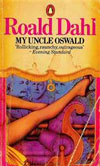 When we think of Roald Dahl, we (and here, I’m talking for the world, like an old tottering professor type) tend to think of him as not being ripe for Cocktail Talk posts, cause he’s probably best known for books in the Children’s section (fantastical, imaginative, adults-read-them-too books, though), such as James and Giant Peach, Charlie and the Chocolate Factory, and more. However, he started as a short story writer, and wrote non-Children’s-section books as well, including a silly-ly naughty one supposedly pulled from the journals a fictitious Uncle Oswald. Oswald was supposedly the greated fornicator of all time, thanks in part to the Sundanese Blister Beetle (which when ground up was a sex bomb of sorts). Oswald’s adventures start, however, listening to a description of whiskey on a hot day:
When we think of Roald Dahl, we (and here, I’m talking for the world, like an old tottering professor type) tend to think of him as not being ripe for Cocktail Talk posts, cause he’s probably best known for books in the Children’s section (fantastical, imaginative, adults-read-them-too books, though), such as James and Giant Peach, Charlie and the Chocolate Factory, and more. However, he started as a short story writer, and wrote non-Children’s-section books as well, including a silly-ly naughty one supposedly pulled from the journals a fictitious Uncle Oswald. Oswald was supposedly the greated fornicator of all time, thanks in part to the Sundanese Blister Beetle (which when ground up was a sex bomb of sorts). Oswald’s adventures start, however, listening to a description of whiskey on a hot day:
‘One evening,’ he began, ‘I was sitting on the verandah of my bungalow way upcountry about fifty miles north of Khartoum. It was hot as hell and I’d had a hard day. I was drinking a strong whiskey and soda. It was my first that evening and I as lying back in the deckchair with my feet resting on the little balustrade that ran round the verandah. I could feel the whiskey hitting the lining of my stomach and I can promise you there is no great sensation at the end of a long day in a fierce climate than when you feel that first whiskey hitting your stomach and going through your bloodstream.’
–Roald Dahl, My Uncle Oswald
October 16, 2010
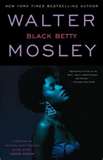
Before leaving for Italy (detailed on my blog Six Months In Italy), I went through and re-read almost all the Easy Rawlins books by Walter Mosley. I think Mosley is one of the finest writers living today, and think the Easy Rawlins books are the best Mosley books (and too often talked about only as detective fiction, which is silly as they transcend genre by the end of the first page, if not the first sentence, of the first book, Devil in a Blue Dress). These books are, like Dickens in a way, imaginative tour de forces due to their ability to summon up a specific time and place (LA is the place for Easy Rawlins, with the times starting in the 50s and moving on up) so completely you become completely immersed in it, and in the characters, which feel real in their motivations and feelings and actions and thoughts, as real as people who walked the earth at any time in history. So, if you haven’t read Mosley, get after it. Black Betty is a book in the middle part of the Easy Rawlins collection, and this quote is one of the best I’ve read about whiskey, the soul of it and the underlying personality whiskey carries with every sip.
There are few things as beautiful as a glass bottle filled with deep amber whiskey. Liquor shines when the light hits it, reminiscent of precious things like jewels and gold. But whiskey is better than some lifeless bracelet or coronet. Whiskey is a living thing capable of any emotion that you are. It’s love and deep laughter and brotherhood of the type that bonds nations together.
Whiskey is your friend when nobody else comes around.
And whiskey is solace that holds you tighter than most lovers can.
–Walter Mosley, Black Betty
 Before you even accuse me of repetitiveness, I already know that I just did a Cocktail Talk post containing an Anthony Trollope quote (the one from The Three Clerks below). Or just a few weeks ago. But, but, but I also just read a different Trollope book, Castle Richmond, and it also had a few worthy quotes, one of which is below. See, I’ve run into a little Trollope luck lately, finding a few of the less-easy-to-find books, and so have been reading my Trollope-loving-heart out. Usually when browsing a bookstore, you’re only going to find a book from the Chronicles of Barsetshire (probably Barchester Towers or The Warden) and maybe something from the Palliser novels (usually, for reasons unknown to me, The Eustace Diamonds, which pales in my mind to Phineas Finn). The lesser known Trollope numbers? Not so much. Which is why, since I recently did find a few of these, A: I’m pretty excited, B: I’ve been reading so much Trollope, and C: why you, lucky people, get another quote about booze and boozing from a Trollope book. This may be, by the way, the finest whiskey punch quote ever. Castle Richmond itself is a darn fine read, an Irish tale which takes place during the potato famine with Trollope’s usual keen observing of politics, both personal and public. And with whiskey punch:
Before you even accuse me of repetitiveness, I already know that I just did a Cocktail Talk post containing an Anthony Trollope quote (the one from The Three Clerks below). Or just a few weeks ago. But, but, but I also just read a different Trollope book, Castle Richmond, and it also had a few worthy quotes, one of which is below. See, I’ve run into a little Trollope luck lately, finding a few of the less-easy-to-find books, and so have been reading my Trollope-loving-heart out. Usually when browsing a bookstore, you’re only going to find a book from the Chronicles of Barsetshire (probably Barchester Towers or The Warden) and maybe something from the Palliser novels (usually, for reasons unknown to me, The Eustace Diamonds, which pales in my mind to Phineas Finn). The lesser known Trollope numbers? Not so much. Which is why, since I recently did find a few of these, A: I’m pretty excited, B: I’ve been reading so much Trollope, and C: why you, lucky people, get another quote about booze and boozing from a Trollope book. This may be, by the way, the finest whiskey punch quote ever. Castle Richmond itself is a darn fine read, an Irish tale which takes place during the potato famine with Trollope’s usual keen observing of politics, both personal and public. And with whiskey punch:



























